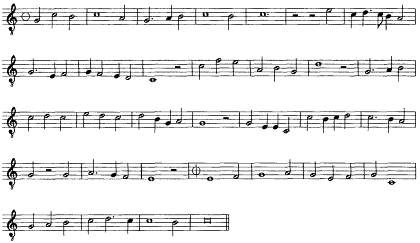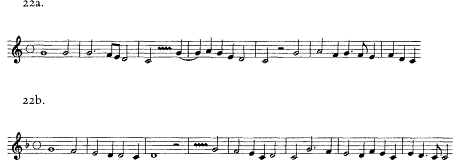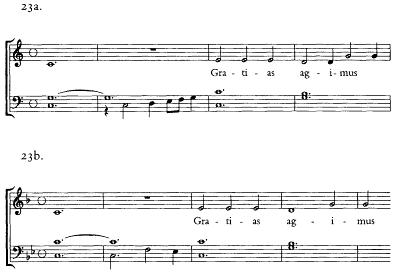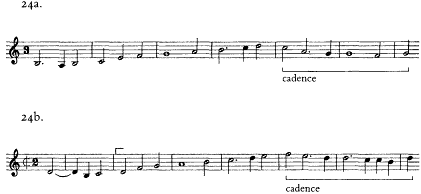Missa, Spb80, Folios 129v-43
A second anonymous Mass in SPB80 has many of the same Fauguesian traits. But despite its use of structural repetition, its contrapuntal and motivic correspondences with other Masses by Faugues, and its similar mensural and rhythmic organization, the three-voice Mass on folios 129v-43 cannot be attributed to Faugues; rather, it is to Faugues what the Missa on folios 122-29 is to Caron: the product of a close contemporary. Although the cantus firmus is unknown, consistent with Masses by Faugues, it appears to be a chanson tenor (see Ex. 21). The melodic emphasis on the c in upper and lower octaves, the contralike leaps in measures 11-13, and the triadic leaps in measures 19-20 suggest a chanson from before 1450; further, the descents down a tenth to c and the triadic, bass-voice pattern in measures 27-28 are both characteristic of the Le serviteur tenor.
In this Mass every movement has at least one section in common with some other movement. As in Faugues's Le serviteur, La Basse danse , and Je suis en la mer Masses, not one but two sections repeat: The Kyrie II returns as the Osanna, and the Cum sancto comes back twice, as the Agnus III and also as the end of the Credo (see Table 21). In
EXAMPLE 21. Tenor of Missa (SPB80, fols. 129v-43), Agnus I

addition, six measures of the Christe (mm. 23-30) return in the Crucifixus (mm. 28-34), and the brief triple-meter (cut-circle) passage at the end of the Et in terra also closes the Agnus I. Thus the Kyrie and Sanctus conclude with the same music, and the beginning and end of the Agnus take from the beginning and end of the Gloria. Remarkably, since the Credo also ends as the Gloria had, every movement shares its last measures with another. With regard to the conclusion of the Gloria and Credo in the Missa , the lengths and texts of the repeated section are the same as those in the Missa Le serviteur . Starting at the text "Cure Sancto spiritu" in the Gloria, the final section requires thirty-six-and-a-half breves to finish in the Missa Le serviteur and thirty-seven in the three-voice Missa . The identical music then returns in both Credos with the words "Et expecto resurrectionem ... Amen"; however, in the Missa the first seven measures are split from the rest, appearing several measures earlier at "Et unam sancram."
Similarities between this Missa and the Missa Le serviteur extend to motive and counterpoint. In some cases the intervallic patterns matter less than how the patterns are organized. For example, the opening measures of both Masses commence with a descent from g to c in the superius (Ex. 22). The motives are not unusual (and the modal context
EXAMPLE 22. Motivic comparison of (a) Missa (SPB80, fols. 129v-43), Kyrie I, mm. 1-3, 6-10; and (b) Faugues, Missa Le serviteur , Kyrie I, mm. 1-3, 7-11

is quite different). But by virtue of being heard three times in the first ten or eleven measures, the motive becomes contextually distinctive. The similarity is aurally enhanced by a deceptive cadence in each.[7]
The Et in terra sections of these two Masses also adhere to similar structural plans. Beginning with duets, the contras present the start of the tenor cantus firmus, condensing eight or nine measures from the Kyrie I into five or six, respectively. When the tenors enter at "Gratias agimus," the bass, tenor, and superius voices are clearly related (see Ex. 23, in which the contra is omitted from the Missa Le serviteur ). Variants of the superius motive subsequently return at "Quoniam tu solus Sanctus." Likewise the duets at the beginning of each Patrem correspond, with the contra presenting tenor material for the first ten measures. And the Gloria, Credo, and Sanctus each have a phrase that Faugues used a step higher in the Agnus II of the Missa L'homme armé (Ex. 24).
The mensural organization of this Missa has many features in common with the Missa Vinnus vina . The various sections of the Kyrie and Sanctus movements use identical mensuration signs, the two Agnus conclude in proportio tripla, and the Credos divide internally at the Crucifixus and the Et in spiritum with the same signs. It was Faugues's
[7] Missa , Kyrie I, m. 8; Missa Le serviteur , Kyrie I, m. 7.
EXAMPLE 23. Motivic comparison of (a) Missa (SPB80, fols. 129v-43), Et in terra, mm. 15-18; and (b) Faugues, Missa Le serviteur , Et in terra, ram. 25-29

normal practice to divide the Credo first at the Crucifixus, but later divisions follow no single pattern. Four break at Et in spiritum, and four at Confiteor. In the Sanctus the Missa Pour l'amour is the only Mass to delay the arrival of tempus imperfectum diminutum until the Benedictus.
Even with these extensive structural correspondences, the Missa has too many features not found in Masses by Faugues. Phrase structure tends too often toward the short and disjunct, in the manner of Barbingant. The greater sectionalization stems from simultaneous rests and, in duple meter, phrase-ending fermatas, a chanson device that Faugues is not known to have used. In one especially choppy portion of the Crucifixus, there are three fermatas within the space of forty-six breves, two of them followed by a breve of simultaneous rest. Rhythmically the portions of the Missa in tempus imperfectum diminutum stick to square patterns that are far less syncopated than normal for Faugues. In its use of motives, aside from those resemblances noted above, the
EXAMPLE 24. Comparison of cadential phrase in (a) Missa (SPB80, fols. 129v-43), Cum Sancto, mm. 29-35; and (b) Faugues, Missa L'homme armé , Agnus II, mm. 60-67

extensive similarities to Faugues's counterpoint seen in the Missa Pour l'amour are lacking. Finally, and less obviously, although the Missa has roughly the same amount of imitation as the Missa Je suis en la mer or the Missa La basse danse , imitation in Faugues's Masses usually occurs at a time interval of two to four semibreves, whereas the most frequent distance in the Missa is a single semibreve or less.
For all of these reasons the anonymous Missa is probably not by Faugues but by someone working closely enough to him—a teacher, student, or colleague—to appropriate several structural (and a few motivic) details, particularly from the Missa Le serviteur . Of these the most characteristic of Faugues is the repetition of extended sections of music. Entire submovements such as the Kyrie II repeat, almost invariably, as the Osanna. Since Faugues also routinely repeats the Osanna (in contrast to Caron), the music of the Osanna is heard three times; for example, as Kyrie II, Osanna I, and Osanna II. The extreme case is the CS14 version of the Missa L'homme armé , in which the Kyrie II returns as the Cum sancto, the Confiteor, and the Osanna (and also the Agnus III?), in other words as the conclusion of each movement of the Mass Ordinary.
Whatever the reason for these repetitions, we cannot infer from
them that Faugues lacked invention. He was as capable of varying contrapuntal lines over repeated statements of a cantus firmus as Ockeghem. A rhetorical significance is possible, even probable, although his repetition schemes seem unrelated to textual ideas. Were this so, there would be more instances of Kyrie sections returning in the Agnus. Nor was Faugues the only composer to repeat movements. As listed in Table 21 there are at least nineteen instances during the fifteenth century, including Masses by Du Fay, Josquin, and Obrecht.
Three of the Masses in Table 21 involve a varied repetition of the Agnus I as the Agnus III. In the so-called Missa de Angelis by Binchois, Louis Gottlieb interpreted the double mensuration sign at the beginning of the Agnus I to call for a double-time rendition of the Agnus III, as occurs in the Touront Missa Monyel .[8] This usage of two mensuration signs also happens in the SPB80 Missa by Petrus de Domarto. There the Agnus I has the sign for tempus perfectum copied directly on top of that for tempus perfectum diminutum . After the Agnus II Ausquier copied the familiar directive "tertium Agnus ut supra." While tempus perfectum diminutum was probably not fully twice as fast as O, a faster tempo for the repetition is clearly indicated.
SPB80 has a significant concentration of Masses with structural repetition. When the instances of Agnus repetition are eliminated (because the texts are so close and Agnus I repetitions so common), and the canonic Trent Missa (because it is so brief), and also the Masses by Josquin, Obrecht, Pipelare, Vaqueras, and the anonymous BolQ16 Missa L'homme armé (because they are all later), what remains from circa 1455-75 are the Du Fay Missa Ecce ancilla , the Regis Missa L'homme armé , the five Masses by Faugues (including the Missa Pour l'amour ), and the three that survive only in SPB80: the Missa Pour l'amour , the anonymous Missa with stylistic ties to Faugues, and the Missa Au chant de l'alouete (attributed to Martini in chapter 9). Faugues and musicians at St. Peter's had an inordinate interest in Masses with structural repetition. If Faugues worked in Rome—as I will now argue—Rome looms as the major source of such Masses. Vaqueras and possibly also Josquin would thus be later representatives of a localized tradition.
[8] Louis Gottlieb, "The Cyclic Masses of Trent Codex 89," 1:74-75. Laurence Feininger published the Binchois Missa under this title in DPLSER, I.